Basic Plasma Research
Basic Plasma Research
The mainstream research & development in plasma happens in the two major areas of basic plasma i.e., experimental as well as theory and simulation studies are carried out. These studies help in understanding the various properties of plasma state in both of naturally occurring and man-made ones. Apart from helping to develop various based technologies, they also help in developing the human resources for future endeavours.

Scientific Programme
Discussion Meeting on Basic Sciences (DiMBS-2022)
Day 1: Wednesday, April 06, 2022
| By Dr.Ing. Suryakant Gupta
| |
Day 2: Thursday, April 07, 2022
| By Dr Shishir Deshpande
|
Basic Experiments in Toroidal Assembly (BETA)
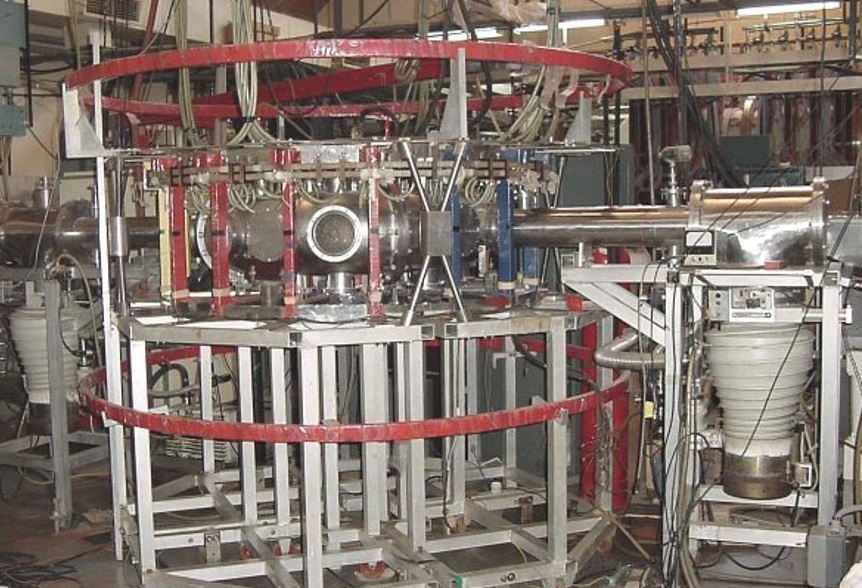
In this experiment, the plasma is being studied in a toroidal assembly which mimics the current-less tokamak (i.e. without the central soleniod). Previously work related to studies of external current drives had been carried out. At present, filamentary produced plasmas are being studied for transport physics and relevant instabilities.
Recent Experiments:
Observation of Toroidal Acoustic Mode in a Current-Less Toroidal Plasma: The existence of a Toroidal Acoustic Mode (TAM) in a nearly collision-less, magnetized current-less toroidal plasma has been demonstrated experimentally. The mode is found to be a discrete, global, axisymmetric mode with measured frequency nearly three times that of √2Cs/(2πR), where Cs=(Te/Mi)1/2, Te is the local electron tempera-ture, and Mi is the ion mass. The observed frequency is found to be independent of the radial location. The mode is found to be driven by the nonlinear interaction of a finite frequency acoustic-like mode with itself. The TAM is a discrete, glob-al mode and is found to exhibit (m=1, n=0) symmetry in density fluctuations and (m≥0, n=0) symmetry in potential fluctuations, where m and n are the poloidal and toroidal mode numbers, respectively. It is found that the TAM mode interacts with the background fluctuations. The observed fre-quency of both the TAM mode and the driver mode is found to scale linearly with 1/√M), where Mi is the ion mass, but with their slopes different by a factor of 2. This mode is found to have characteristics similar to Geodesic Acoustic Modes often found in Tokamaks.
Recent Publications:
1) Observation of Toroidal Acoustic Mode in a Current-Less Toroidal Plasma. UMESH KUMAR, R. GANESH, SATHYANARAYANA KRISHNAMACHARI, and Y. C. SAXENA. Physics of Plasmas, 26, 072307, July 2019
Large Volume Plasma Device (LVPD)

Investigation of the fundamental processes in naturally occurring plasma is important as they are responsible for a large release of energy, generation of powerful electromagnetic radiation, and acceleration of energetic particles, etc. which have consequences to earth bound activities. A modest size laboratory plasma device is necessary to study those phenomena with minimum boundary effects. For this purpose a Large Volume Plasma Device has been constructed and various experiments are being carried out.
Recent Experiments:
Electron Temperature Gradient Turbulence Induced Energy Flux: The Large Volume Plasma Device (LVPD) has successfully demonstrated excitation of the Electron Tempera-ture Gradient (ETG) driven turbulence in the finite plasma beta (β~0.06−0.4) condition, where the threshold condition for ETG turbulence, the ratio of density scale length to the temperature scale length, greater than 2/3 is satisfied. The observed mode follows wave vector scaling and frequency ordering as k⊥ρe ≤1<< k⊥ρi,Ωi < ω<< Ωe, where k⊥ is the perpendicular wave vector, ρe,ρi are Larmor radii of the elec-tron and ion, respectively, and Ωi,Ωe,ω are the ion, electron gyro frequencies and the mode frequency, respectively. Si-multaneous measurement of fluctuations in electron tempera-ture, ~(10−30)%, plasma density ~(5−12)%, and potential~(1−10)% are obtained. A strong negative correlation with correlation coefficients of~−0.8 and ~−0.9 are observed be-tween the density and potential and temperature and potential fluctuations, respectively. These correlated density, tempera-ture, and potential fluctuations lead to the generation of tur-bulent heat flux. The measured heat flux is compared with the theoretically estimated heat flux from ETG model equations. The experimental result shows that the net heat flux is di-rected radially outward.
Observation of Electromagnetic Fluctuation induced Parti-cle Transport in ETG Dominated Large Laboratory Plasma: The large volume plasma device (LVPD), a cylindrically shaped, linear plasma device of dimension (Φ = 2 m, L = 3 m) has been used to successfully demonstrate the excitation of electron temperature gradient (ETG) turbulence. The observed ETG turbulence shows significant power for rotation-al modes of frequencies 25 to 90 kilo-radians per second for corresponding wavenumbers ~ (0.1 – 0.2)/(electron larmor radius). The observed frequency and wave number matches well with theoretical estimates corresponding to Whistler-ETG mode. We investigated electromagnetic (EM) fluctua-tions induced plasma transport in high beta (~0.01 - 0.4) ETG mode suitable plasma in LVPD. The radial EM electron (ion) flux are found to be resulting primarily from the correlation between fluctuations of parallel electron current and radial magnetic field. The EM particle flux is observed to be much smaller than the electrostatic particle flux. The EM flux is small, but finite, contrary to the conventional slab ETG mod-el. A theoretical model has been developed for the EM par-ticle flux in straight homogeneous magnetic field geometry. The estimates from the model are seen to compare well with the experimental observations. Sluggish parallel ion response is identified as the key mechanism for generation of small but finite EM flux.
Radial Variation of Electron Temperature Gradient in a Double Plasma Laboratory Device: Radial control of the electron temperature gradient is demonstrated in a double plasma device (figure A.2.1) by making use of segmented grid bias-ing. The plasma produced in the source region is allowed to diffuse into the target region through a single grid as well as through the cassette of multiple-grid assembly, under dif-ferent grid bias conditions. Both electron heating and cool-ing are observed radially at one location in the target region when a single grid is used. The electrons are cooled down to a temperature of 3.3eV from 5.1eV when the grid bias is raised from −25 to 0V. Similarly, during heating, the electron temperature increases from 4.8 to 7.3eV when the grid bias is varied between 0 and +20V. Two different transparencies of grids, 45% transparency (mess-size, m = 0.8mm~λDe) and 75% transparency (mess-size, m=2.4mm>λDe), are used, where the value of λDe ≈ 0.8mm. The obtained elec-tron energy distribution function suggests that a grid with less transparency is more effective in cooling the electrons because of insignificant energetic electron–neutral collisions in the target region as a sheath in the close vicinity of grid al-lows only the high energetic electrons to pass through it. The higher transparent grid, on the other hand, produces electron heating as it exerts a negligible influence on the free flow of accelerated high energy electrons to target plasma due to insignificant thermalization. We expanded this concept and, for novelty, applied it to a radially segmented grid assembly of electrically isolated grids, for effectively charging differ-ent plasma regions with differently various potentials for ex-erting a radial control on electron temperature. The results obtained show that a significantly sharp electron temperature gradient is obtained with a typical gradient scale length of LTe ~ 10cm in the target plasma region. The outcome of this study may be useful both in plasma processing applications and for studying plasma turbulence in unmagnetized plasmas
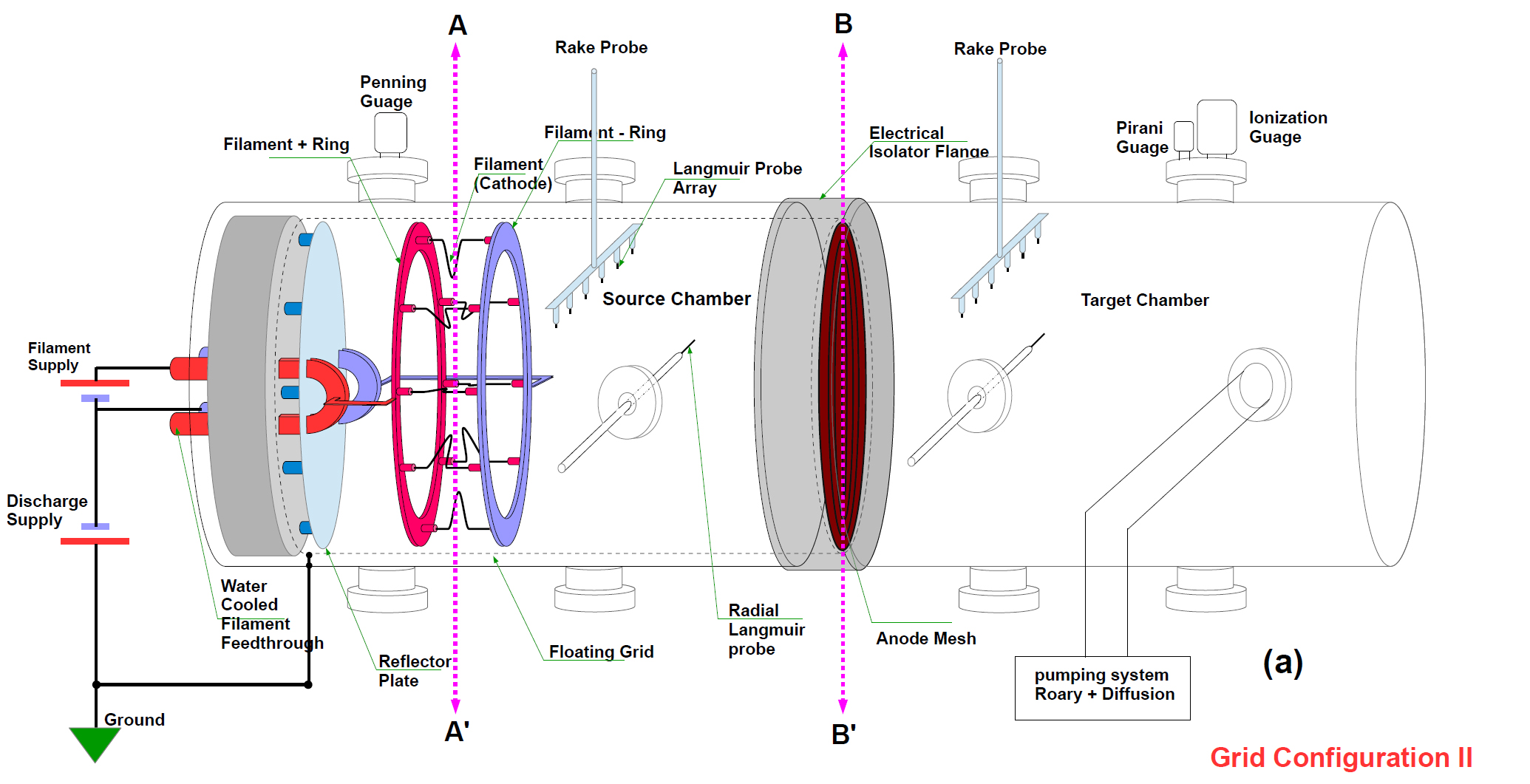
Figure a The schematic of the double plasma device (DPD) showing source and target chambers isolated by a Perspex ring ‘I’. The cross-sectional view of the filament (A-A’)
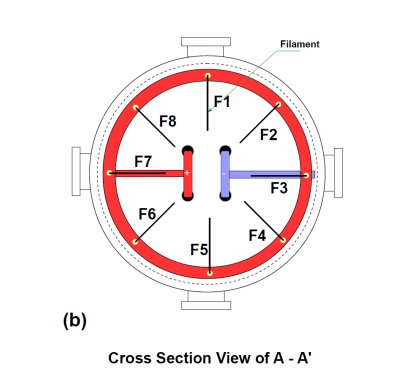 | 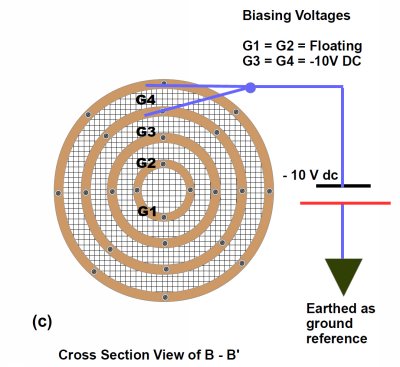 |
Recent Publications:
1)Observation of Electromagnetic Fluctuation induced Particle Transport in ETG Dominated Large Laboratory Plasma. PRABHAKAR SRIVASTAV, RAMESWAR SINGH, L M AWASTHI, A K SANYASI, P K SRIVASTAVA, RITESH SUGANDHI and R SING. Plasma Physics and Controlled Fusion, 61, 055010, May 2019
2)Electron Temperature Gradient Turbulence Induced Energy Flux in the Large Volume Plasma Device, PRABHAKAR SRIVASTAV, RAMESWAR SINGH, L. M. AWASTHI, A. K. SANYASI, P. K. SRIVASTAVA, RITESH SUGANDHI, and R. SINGH. Physics of Plasmas, 26, 052303, May 2019
3)Electro-Mechanical Probe Positioning System for Large Volume Plasma Device
A. K. SANYASI, R. SUGANDHI, P. K. SRIVASTAVA, PRABHAKAR SRIVASTAV, and L. M. AWASTHI
Review of Scientific Instruments, 89, 055113, 2018
Non-Neutral Plasma Device (SMARTEX-C)
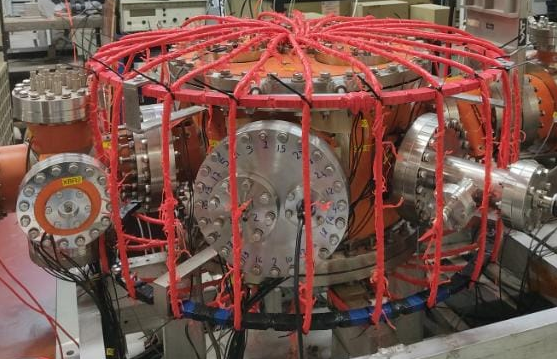
Laboratory plasmas are generally electrically neutral i.e. the number densities of postive and negative charges particles are nearly same. This helps in keeping the plasma stable for some time. It has been observed that the removal of this neutral condition gives more exciting physics and interesting observations.The simplest non-neutral plasmas are plasmas consisting of a single charge species like electrons. A simple toroidal device has been constructed to study these non-neutral plasmas consisting of only electrons.
Recent Experiments:
Extension of diocotron mode period: Evolution of launched diocotron mode frequency of trapped toroidal electron plasma extending 40 second has been observed in Small as-pect ratio partial toroidal experiment named SMARTEX-C (SMall Aspect Ratio Toroidal Electron plasma eXperiment – in ‘C’). Exponential decay rate of stored charge for 100 - 300 Gauss range is observed to be independent of B-field at filament injection energy of 250 eV. Contamination of elec-tron plasma by newly added electrons due to ionization of background neutral gas has to be lowered. Radial profile of floating potential of electron plasma using High impedance Langmuir probe diagnostics was attempted. To indirectly es-timate the electron plasma temperature, gas puff of definite quantity of different gases has been investigated by launching diocotron mode at different instance of time. Effect of heavy gas molecules like N2 and Argon as a function of gas pressure and interaction time with plasma has been investigated in de-tail. Diocotron launch technique was characterized for wave launch parameters to infer the data with better accuracy.
Recent Publications:
1) Confinement time of electron plasma approaching magnetic pumping transport limit in small aspect ratio C-shaped torus, Lavkesh Lachhvani, Sambaran Pahari, Rajiv Goswami, Manu Bajpai, Yogesh Yeole, and P. K. Chattopadhyay, Physics of Plasmas 23 062109 (2016)
2) Investigation of diocotron modes in toroidally trapped electron plasmas using non-destructive method, Lavkesh Lachhvani, Sambaran Pahari, Sudip Sengupta, Yogesh G. Yeole, Manu Bajpai, and P. K. Chattopadhyay, Physics of Plasmas 24 102132 (2017)
Dusty Plasma Experiments(DPEx)
Plasma consists usually of ions and electrons and the dominating force between them is electromagnetic the magnitude of which depends on the charge of the individual partices. If the charge on the individual partices can be increased to multiple times (of course, multiple times of electronic charge which is fundamental), then the relevant forces between the particles can be very very strong. Introduction of dust particles into a plasma, which is otherwise pure, can give plasmas with particles of multiple charges. This is because each dust particle can carry multiple electrons and hence the coupling forces will be very very strong. The size of the dust particles and the background plasma in these experiments help to study those strongly coupled plasma in controlled environments.
Recent Experiments:
Experimental Investigation of Test Particle Induced Micro-Structural Changes in a Finite Two-Dimensional Complex Plasma Crystal: The microstructural changes induced in a two dimensional complex plasma crystal by the movement of a single extra particle existing below it are investigated experimentally using a DC glow discharge device. The finite monolayer crystal consisting of mono-dispersive melamine formaldehyde particles is created in the background of an Ar-gon plasma. The crystal formation is frequently found to be accompanied by the presence of one or more slightly heavier particles suspended a little below the monolayer. The inter-play of one such test particle with the crystal is investigated for two distinct cases—(i) when the particle remains confined (trapped) in the space below the crystal and (ii) when it in-teracts for a short time with the crystal and then moves out of the vicinity. The trapped particle orbit induces permanent structural changes in the crystal in the form of micro-cracks, and these changes are identified using a variety of diagnostic analyses. The cracks can be enhanced by energizing the test particle with an incident laser. The passing particle, on the other hand, induces only transient changes in the crystal from which it is able to recover and return to its initial state in a clear demonstration of the viscoelastic property of a strongly coupled system.
Effect of size and shape of a moving charged object on the propagation characteristics of precursor solitons: Experimental observations show the modifications in the propagation characteristics of precursor solitons due to the different shapes and sizes of the object over which the dust fluid flows. The experiments have been performed in a P shaped Dusty Plasma Experimental device where dusty plasma is created in a DC glow discharge Argon plasma using kaolin particles. A floating copper wire installed radially on the cathode acts as a charged object in the plasma environment. The flow on the dust fluid is initiated by suddenly lowering the potential of the charged object from grounded potential to close to float-ing potential. The size (height and width) of the potential hill is varied by drawing current from the wire through a vari-able resistance. With a decrease in the height of the potential hill, the amplitude, velocity, and number of excited precursor solitons are found to decrease, whereas the widths of solitons are seen to increase. It is found that below a threshold value, these solitary waves are not excited, and the dust fluid simply flows over the hill. To examine the effect due to the shape of the potential profiles, the wire is replaced by a triangular object. Only trailing wakes are seen to be excited when the dust fluid faces the linearly increasing slope of the potential profile, whereas both solitons and wakes get excited when the object is placed with the sharp edge facing the flow. All the experimental findings qualitatively agree with numerical solutions obtained with different source terms in the forced-Korteweg–de Vries model equation.
Recent Publications:
1) Effect of size and shape of a moving charged object on the propagation characteristics of precursor solitons, GARIMA ARORA, P. BANDYOPADHYAY, M. G. HARIPRASAD and A. SEN
Physics of Plasmas, 26, 093701, September 2019
2) A Dust Particle Based Technique to Measure Potential Profiles in a Plasma
GARIMA ARORA, P. BANDYOPADHYAY, M. G. HARIPRASAD, and A. SEN
Physics of Plasmas, 25, 083711, 2018
3)Experimental Investigation of Dynamical Structures Formed Due to a Complex Plasma Flowing Past an Obstacle
S. JAISWAL, M. SCHWABE, A. SEN, and P. BANDYOPADHYAY
Physics of Plasmas, 25, 093703, 2018
4) Experimental Observation of a Dusty Plasma Crystal in the Cathode Sheath of a DC Glow Discharge Plasma
M. G. HARIPRASAD, P. BANDYOPADHYAY, GARIMA ARORA, and A. SEN
Physics of Plasmas, 25, 123704, 2018
5) Micro-Dynamics of Neutral Flow Induced Dusty Plasma Flow
GARIMA ARORA, P. BANDYOPADHYAY, M. G. HARIPRASAD, and A. SEN
Physics of Plasmas, 26, 023701, 2019
6) Experimental Observation of a First-Order Phase Transition in a Complex Plasma Monolayer Crystal. M. G. HARIPRASAD, P. BANDYOPADHYAY, GARIMA ARORA and A. SEN, Physical Review E, 101, 043209, April 2020
7) Excitation of Dust Acoustic Shock Waves in an Inhomogeneous Dusty Plasma. GARIMA ARORA, P. BANDYOPADHYAY, M. G. HARIPRASAD and A. SEN, Physics of Plasmas, 27, 083703, August 2020
8) Experimental Observation of Pinned Solitons in a Flowing Dusty Plasma. GARIMA ARORA, P. BANDYOPADHYAY, M. G. HARIPRASAD and A. SEN, Physical Review E, 103, 013201, January 2021
Multi-Cusp Plasma Device

A cusp magnetic configuration is formed by two parallel electromagnets with the current running in opposite directions, creating oppositely directed magnetic fields. The two fields interact to form a field free area between them which can used to confine plasmas. To confine plasmas of bigger volume multiple cusps are used. In this experiment, the field free volume is produced by six electromagnets in a multi-pole line-cusps configuration. This configuration helps to produce quiecent plasmas which is necessary for fundamental studies as well as applications like negative ion beam sources.
Recent Experiments:
Characterization of Argon Plasma in a Variable Multi-Pole Line Cusp Magnetic Field Configuration: A detailed characterization of argon plasma confined by a multi-pole line cusp magnetic field (MMF) over a large cylindrical volume (1 m axial length and 40 cm diameter) has been done. Various magnetic field configurations with various magnet current scenarios have been obtained from the magnetic field simula-tion in the vacuum. From the experimental results, it is been observed that for such a field configuration the confinement of the primary electrons increases and leak width (plasma es-caping through the cusp) of plasma decreases with increasing the magnetic field. As a result the mean density, particle con-finement time and the stability of the plasma increase with increasing magnetic field values. In addition to this, the radial uniformity of the plasma density across the magnetic field is found to be explicitly depending on the magnetic field values of MMF. Moreover, the nature of turbulence in a quiescent argon plasma has been identified.
Evidence for neutrals carrying ion-acoustic wave momentum in a partially ionized plasma: An experimental study of Ion Acoustic (IA) wave propagation is performed to investigate the effect of neutral density for Argon plasma in an unmag-netized linear plasma device. The neutral density is varied by changing the neutral pressure, which, in turn, allows the change in ion-neutral, and the electron-neutral collision mean free path. The collisions of plasma species with neutrals are found to modify the IA wave characteristics such as the wave amplitude, the velocity, and the propagation length. Unlike the earlier reported work where neutrals tend to heavily damp the IA wave, the present study suggests that the ion-neutral collisions support the wave to propagate for longer distanc-es as the neutral pressure increases. This happens when the ion-neutral collisional mean free path is comparable to the wavelength of the wave. A simple analytical model is derived to qualitatively support the experimental findings. This study was done on a Twelve Pole Six Magnets (TPSM) configura-tion (Figure A.2.2a) which has been found to have better con-finement properties than the Six Pole Six Magnets (SPSM) configuration (Figure A.2.2b). Both of these configurations can be obtained in the Multi-Cusp Plasma device by passing appropriate currents in the electromagnets.
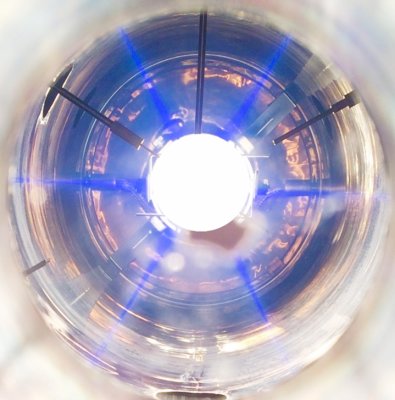 | 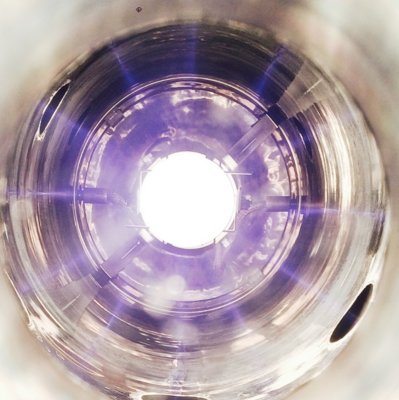 |
(a) Twelve Pole Six Magnets and (b) Six Pole Six Magnets configurations of the Multi-Cusp Plasma Device.
Recent Publications:
1) Evidence for neutrals carrying ion-acoustic wave momentum in a partially ionized plasma. MEENAKSHEE SHARMA, A. D. PATEL, ZUBIN SHAIKH, N. RAMASUBRAMANIAN, R. GANESH, P. K. CHATTOPADHAYAY and Y. C. SAXENA. Physics of Plasmas 27, 022120, February 2020
2) Characterization of Argon Plasma in a Variable Multi-Pole Line Cusp Magnetic Field Configuration. A. D. PATEL, M. SHARMA, N. RAMASUBRAMANIAN, J. GHOSH and P. K. CHATTOPADHYAY. Physica Scripta, 95, 035602, February 2020
3) A New Multi-Line Cusp Magnetic Field Plasma Device (MPD) with Variable Magnetic Field
A.D. PATEL, M. SHARMA, N. RAMASUBRAMANIAN, R. GANESH, and P. K. CHATTOPADHYAY
Review of Scientific Instruments, 89, 043510, 2018
4) Experimental Observation of Drift Wave Turbulence in an Inhomogeneous Six-Pole Cusp Magnetic Field Of MPD
A. D. PATEL, M. SHARMA, R. GANESH, N. RAMASUBRAMANIAN, and P. K. CHATTOPADHYAY
Physics of Plasmas, 25, 112114, 2018
5) Role of Multi-Cusp Magnetic Field on Plasma Containment. MEENAKSHEE SHARMA, A. D. PATEL, N. RAMASUBRAMANIAN, Y. C. SAXENA, P. K. CHATTOPADHYAYA and R. GANESH, Plasma Research Express, 2, 045001, December 2020
Magnetized Linear Plasma Device
Recent Experiments:
Positive Ion Impediment across Magnetic Field in a Partially Magnetized Plasma Column: The radial characterization of a partially magnetized plasma column created by a hot cathode filament has been done. It is found that in the absence of a magnetic field, plasma potential and density profiles follow the Boltzmann distribution. However when a magnetic field is introduced, a clear divergence from Boltzmann distribu-tion is seen as the plasma density becomes more pronounced in the center whereas a corresponding minima is observed in plasma potential. This radial potential profile impedes the radial diffusion of positive ions towards the grounded side-walls. A phenomenological model based on short-circuiting effect is developed, which fairly explains this contrasting be-havior
Influence of Cold Hollow Cathode Geometry on the Radial Characteristics of Downstream Magnetized Plasma Column: The effect of cathode geometry on the radial characteristics of a downstream plasma column has been studied for a cold cathode type of hollow cathode (HC) system. It is observed that when an axial magnetic field is applied to a cylindrical cathode, the downstream plasma exhibits an off-centered peak in the plasma density. However, as the magnetic field increases, the discharge extinguishes rapidly above a critical value, due to the suppression in secondary electron emission from the cylindrical cathode surface. On the other hand, by replacing the hollow cylinder with a cone-shaped cathode an oblique sheath is formed with respect to the axial magnetic field. This configuration helps in sustaining the discharge at twice the magnetic field than in the cylindrical case. It is also found that the downstream plasma exhibits a peak plasma density at the center for the case of the conical cathode. A phenomenological model explaining the above experimental observations for each HC setup has been developed which helps to understand the phenomena qualitatively.
Understanding Langmuir Probe Characteristics of a Magnetized Plasma Column in Partial Contact with Grounded Probe Reference: An experimental investigation has been carried out on Langmuir probe measurements in a magnet-ized plasma column which exhibits two-temperature electron populations. It is a known fact that probe I(U) traces follow the usual exponential law if the measurements are performed with a reference electrode in good contact with plasma; which is usually a grounded discharge electrode. However in the present case, as the grounded probe reference is not a part of the discharge circuit the resulting I(U) analysis is not straightforward. It is found that owing to the high im-pedance between bulk plasma and probe reference, the probe measurement results in lower values of electron saturation current as compared to the ideal scenario. For an appropri-ate correction, a simple analysis technique has been proposed to interpret probe I(U) traces resulting from such magneto-plasma devices, where reference to the probe is in partial/ poor contact with the bulk plasma. This correction is found to be satisfactory.
Recent Publications:
1) Understanding Langmuir Probe Characteristics of a Magnetized Plasma Column in Partial Contact with Grounded Probe Reference. M.P. BHUVA, S.K. KARKARI and S. KUMAR. Journal of Instrumentation, 14, T11009, November 2019
2) Influence of Cold Hollow Cathode Geometry on the Radial Characteristics of Downstream Magnetized Plasma Column. M. P. BHUVA, S. K. KARKARI and SUNIL KUMAR. Plasma Sources Science and Technology, 28, 115013, November 2019
3) Positive Ion Impediment across Magnetic Field in a Partially Magnetized Plasma Column. SATADAL DAS and SHANTANU K KARKARI. Plasma Sources Science and Technology, 28, 075013, July 2019
4) A Hybrid Probe System for Quantifying Plasma Parameters in a 13.56 Mhz Capacitive Coupled Magnetized Plasma J. K. JOSHI, S. BINWAL, S. K. KARKARI and SUNIL KUMAR
Review of Scientific Instruments, 89, 113503, 2018
Whistler Wave Studies
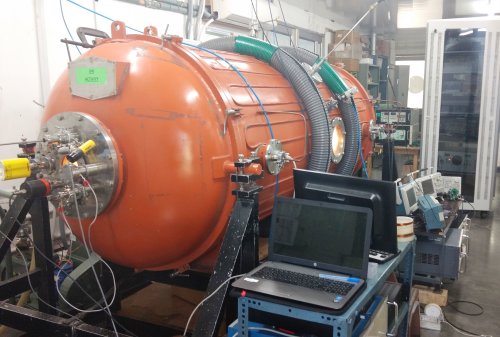
Figure: The experimental device to study the Whistler waves
Recent Experiments:
Whistler Wave Propagation and Interplay between Electron Inertia and Larmor Radius Effects:
The influence of Lar-mor radius effects on the propagation of whistler waves is investigated experimentally in laboratory plasma. The waves are excited using a loop antenna of diameter less than the electron skin depth, the natural scale length in this regime. In an earlier experiment, it was shown that such waves as-sume an elongated shape with perpendicular dimensions of the order of skin depth. In the present work, we show that wave propagation is significantly modified when the external guiding magnetic field is decreased. The wave spreads in the perpendicular direction in spite of starting of as an elongated whistler due to electron inertia effects. In the near region, the antenna field becomes dominant even forming null points, with the physical processes taking shape and wave still being guided by the net background magnetic field. However, the feeble external magnetic field in the region away from the antenna is unable to guide the wave any further and the wave spreads. In spite of a large current pulse, the wave remains linear (∆B/B0≤1). The observed results are attributed to the interplay between electron inertia and finite Larmor radius ef-fects and are explained in terms of a modified physical model.
- Homi Bhabha National Institute
Discussion Meeting on Basic Sciences (DiMBS-2022)
Basic ExperimentsBasic Experiments in Toroidal Assembly (BETA)- Large Volume Plasma Device (LVPD)
- Non-Neutral Plasma Device
- Dusty Plasma Experiments(DPEx)
- Multi-Cusp Plasma Device
- Magnetized Linear Plasma Device
- Other Devices



